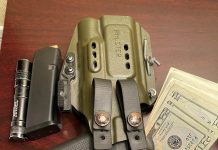“Armor piercing ammo” is a phrase thrown about by the poorly informed with rabid abandon when the media types are looking to make something sound scarier.
‘Capable of firing armor piercing rounds!’ is one such misnomer. If an armor piercing round is made in “X” caliber or chambering and any firearm is in “X” caliber or chambering, then yes, it is “capable” of firing armor piercing rounds. But you need to have those rounds, and they are expensive. Also not nearly as useful as one might surmise from the fear spoken of in mass media. AP can punch through hardened steel. Cool. But unless you’re taking on something made of hardened steel it’s a probably a wasted expense.
The same with API, Armor Piercing Incendiary, a round which is designed to ignite whatever is behind the original hardened barrier. Fuel, ammunition, sensitive equipment, etc. All those items are the most likely targets of an API round. Not a guy with a plate carrier on.
Armor piercing ammo is meant for and is most effective against equipment. Personnel are a secondary target and aren’t that much more at risk from an AP round than a conventional one. Both ammunition types are lethal.
When the Media says ‘Armor Piercing’
They mean rifle ammo.
Any rifle ammo, except .22 lr, they like .22’s
They either lack understanding of personal body armor, or are projecting willfully misleading information. In either case its problematic towards developing an understanding of a round type that can defeat armor vs. one that is armor piercing by design.
Media reports that cite AP as a capability are referencing the fact that standard soft armor, rated level II or IIIA under current designations (likely redesignated P1 and P2 under new armor regulations), do not stop rifle rounds. They are rated for handgun rounds. Cops wear the far more mobile and less burdensome handgun rated armor because, statistically speaking, that’s the threat they are going to encounter by many orders of magnitude.
If a rifle threat is known or suspected, hard armor of level III or IV can be used in a supplemental vest, often known as a plate carrier. These plates protect a 10×12 (medium plate) space on the chest and back to lower the chance a rifle round hits the heart and lungs. Level IV plates are even rated to a certain degree against armor penetrating rounds (M2 AP 30-06) for a manufacturer stated number of strikes. “Multi-hit capable” is the usual nomenclature.

Understanding Armor and Armor Penetration
The concept of armor is nothing new, we’re talking millenia old. Weapon designed-> armor designed->weapon to defeat ->armor to beat weapon… and so on. Today’s iterations are centered on handgun, rifle, shrapnel, and knife threats. All dependant on the level of protection that makes sense vs. the mobility trade off and the threat environment.
There is always a weapon that will beat the armor or a way that the armor will be ineffective (IE: head shot) at stopping the threat. Equally there is a level of armor that, despite a threat, does not make sense to equip against due to the unlikely nature of the threat or the mobility decrease that comes with using the armor. We can look at how plate carriers changed during OEF/OIF/GWOT to see that the conclusion has become, in most circumstances, mobility is more important.
Defeating modern armor comes by combining a dense enough substance with enough speed to defeat the barrier. A technique we can trace back to the middle ages Bodkin arrow tip.
“Armor Penetrating” is relative.
AP or API is specifically an anti-vehicle/anti-material designate. The target is armored vehicles and materials.
Dependant upon the level of personal armor being worn a round may or may not be stopped. It will depend upon the rating of the armor. So a rifle round is not tailored to defeat pistol rated armor, but it will. That does not make the rifle round AP. If the round is designed from the ground up to defeat a level of armored threat it is AP. If in it’s design layout it can defeat a certain level of armor or protection then it is ‘capable of armor penetration’ but wasn’t designed to pierce armor as a principal design consideration.
Semantics? Perhaps in the general scale it does not matter if a design was purpose built to defeat a protection if it can do so, however from the point of “The Narrative” it matters highly.
When a round is being portrayed as a ‘cop killer’ bullet or hyper dangerous in some other manner, “weapon of mass destruction” is the favorite right now, it matters. When commercially long standing rounds, like 30-06, have power factors substantially higher than those calibers being maligned and possess the same “armor penetrating” capability of not being a handgun round it makes for too easy a narrational slope. Leading to the suggestion that the only way to be safe from “armor piercing ammo” is to ban all ammo… and guns.
Thanks to the InRange crew for the video on real AP and API.



